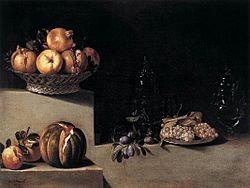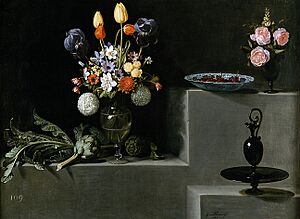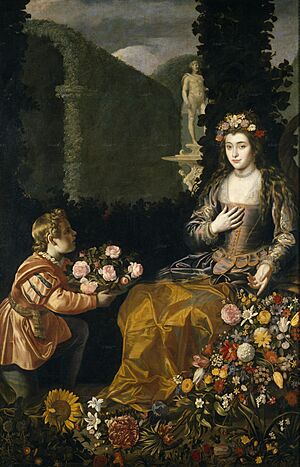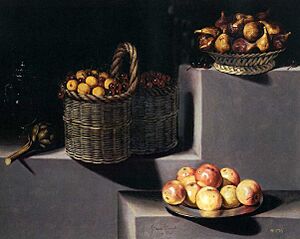Juan van der Hamen facts for kids
Quick facts for kids
Juan van der Hamen
|
|
|---|---|

Still life with fruits and glassware,
Museum of Fine Arts, Houston |
|
| Born |
Juan van der Hamen y Gómez de León
bapt. 8 April 1596 |
| Died | 28 March 1631 (aged 34) |
| Nationality | Spanish |
| Known for | Painting |
| Movement | bodegones, still life |
Juan van der Hamen y Gómez de León (born 1596 – died 1631) was a Spanish painter. He was a master of still life paintings, also known as bodegones. He painted many different types of art, including allegories, landscapes, and large works for churches. Today, he is best known for his still lifes. He helped make this type of painting popular in Madrid in the 1620s.
Contents
About Juan van der Hamen
Juan van der Hamen was born in Madrid, Spain, around April 1596. His father, Jan van der Hamen, was from Flanders (a region in modern-day Belgium). He worked for the King of Spain in Madrid. Juan's mother, Dorotea Witman Gómez de León, was half-Flemish and had Spanish family roots.
Juan and his two brothers, Pedro and Lorenzo, used their mother's family name, Gómez de León. This showed their Spanish heritage. Juan followed in his father's footsteps by working for the Spanish royal court. He became a painter for the king, though he wasn't paid a regular salary. His first known painting for the king was a still life in 1619. It was for a country palace near Madrid.
Juan van der Hamen's Artworks

Juan van der Hamen was known for painting many different things. He created religious scenes, allegories (paintings with hidden meanings), landscapes, and portraits. But his still lifes and portraits brought him the most fame. He worked for King Philip III and King Philip IV. He helped make still life paintings very popular in Madrid during the 1620s.
He was a very busy artist. He painted all his known works during the first ten years of King Philip IV's rule. He painted more still lifes in 1622 than in any other year.
Famous Portraits
Juan van der Hamen was also a successful portrait painter. This type of art brought him more personal success, as still life was seen as a less important style. He painted a portrait of King Philip IV. During the 1620s, he also painted many important writers and thinkers of his time. These included famous authors like Lope de Vega and Francisco de Quevedo. When he died, twenty of these portraits were listed among his belongings.
One of his famous portraits is of a dwarf, painted around 1623. This painting showed a very realistic style. It was similar to later works by the famous artist Diego Velázquez.
In 1626, van der Hamen painted Cardinal Francesco Barberini. The Cardinal liked van der Hamen's work so much that he bought three more paintings from him.
Religious Paintings
Juan van der Hamen also painted for churches and religious groups. He worked in and around Madrid and Toledo. For example, he painted altars for the Monastery of the Descalzas Reales in Madrid. Not many of these religious paintings still exist today. Some of his best surviving religious works are in the Royal Convent of La Encarnación in Madrid. He painted them in 1625 in a natural, dark style.
Flower Paintings

Juan van der Hamen was also one of the first artists to specialize in flower paintings. He probably started painting flowers after seeing the works of Flemish artists like Jan Brueghel the Elder. These artists were famous for their flower pieces, and their paintings were popular in Spain.
A great example of his flower painting is Offering to Flora. This large painting, created in 1627, shows the goddess of flowers sitting next to a basket of spring flowers. It combines his skills as a portrait painter and a flower painter. This painting was part of the decorations in a palace in Madrid. Two of his biggest supporters, Jean de Croy and Diego Mexia, owned many of his works.
Juan van der Hamen died in Madrid on March 28, 1631. He was only 35 years old. Today, his paintings are shown in major museums across Europe and America. In 2006, an exhibition of his paintings was held in Madrid and Dallas, bringing his work to more people.
Still Life Paintings
Juan van der Hamen is well known as a talented still life painter from Spain's Golden Age. However, during his lifetime, other artists admired him more for his portraits, allegories, landscapes, and religious works. Today, he is mostly remembered for his still lifes.
Still life painting was once considered a less important type of art. But it became very popular in the 17th and 18th centuries. In Spain, these paintings were called bodegones. They often showed everyday objects in a simple, dark style. Van der Hamen was seen as the best Spanish still life painter of his time. He helped make still life a respected art form on its own.
Van der Hamen's still lifes show a strong influence from Flemish art. But they also reflect the style of paintings made in Toledo by Juan Sánchez Cotán. Cotán often showed fruits and vegetables hanging from a window or placed on a ledge. Van der Hamen took this style and made it fit the busy life of Madrid. He used more detailed objects and foods, like fancy Venetian glass and ceramic pots.
He placed these objects on a simple shelf, with a dark background behind them. A strong light shone on the objects, making them stand out. Their neat, zigzag arrangement and the strong shadows created a calm feeling of space. Sometimes, objects like wafers would extend over the edge of the shelf, making them seem closer to the viewer.
After 1626, van der Hamen started making his still lifes more complex. He placed objects on different levels. This style may have come from Rome in the early 1620s. However, van der Hamen used fewer objects than the Roman painters. He arranged them in a balanced way, with strong Spanish lighting. This allowed him to focus on each object, making its shape and texture seem very real.
Juan van der Hamen's still lifes greatly influenced other painters. These included Francisco and Juan de Zurbarán, a father and son, and later artists like Antonio Ponce.
One special feature of van der Hamen's still lifes was his skill at painting expensive glassware. He was very good at showing the shine and details of these glass pieces.
He arranged the objects in his paintings in geometric shapes, like circles and spheres. He carefully placed them on stepped stone ledges, changing how light hit each one. He masterfully painted fruits, vegetables, wood, clay, and crystal. He also carefully planned the colors and shadows to create a harmonious and simple, yet carefully structured, painting.
Where to See His Art
Besides the excellent paintings in The Prado Museum, other Spanish museums also have works by Van der Hamen. The Real Academia de Bellas Artes de San Fernando has six of his paintings. The Thyssen-Bornemisza Museum has a piece called Still Life with Porcelain and Sweets. The Museum Cerralbo in Madrid has Bowl of Peaches. The Granada Fine Arts Museum and The Asturias Fine Arts Museum each have one painting.
Images for kids
-
Vase and Fruit bowl. Real Academia de Bellas Artes de San Fernando. Madrid
-
Still Life with Porcelain and Sweets. Thyssen-Bornemisza Museum, Madrid.
-
Still life with Candy boxes. Museo de Bellas Artes de Granada. Granada.
See also
 In Spanish: Juan van der Hamen para niños
In Spanish: Juan van der Hamen para niños






